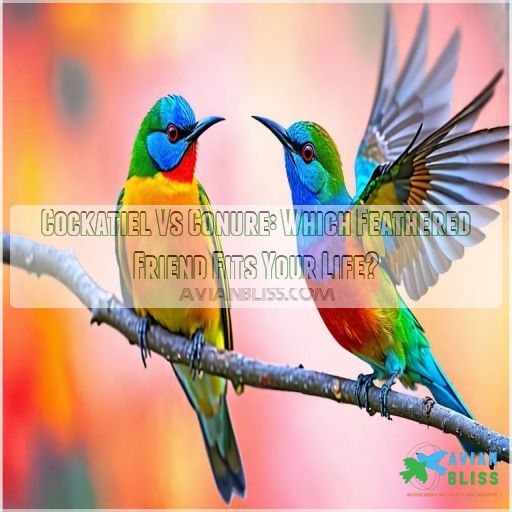This site is supported by our readers. We may earn a commission, at no cost to you, if you purchase through links.
 Choosing between a cockatiel and a conure can feel like picking between two fun-loving friends.
Choosing between a cockatiel and a conure can feel like picking between two fun-loving friends.
Cockatiels are the quieter buddies, with gentle whistles and sweet dispositions, making them ideal for laid-back homes.
Conures, on the other hand, bring the party with their vibrant colors and playful antics, though they can be a bit noisy.
Both need love, training, and a healthy diet to thrive.
Cockatiels might suit beginners better since they’re easier to train, while conures are for those ready for a lively companion.
Whether you’re after serenity or sparks, these feathered friends promise joy.
Curious for more tips?
Table Of Contents
- Key Takeaways
- Cockatiel Vs Conure: Key Differences
- Cockatiels: Gentle Companions for Beginner Bird Owners
- Conures: Energetic and Colorful Feathered Friends
- Living Space and Cage Requirements
- Social Needs and Interaction With Humans
- Training Potential and Mental Stimulation
- Cost Comparison: Cockatiel Vs Conure Ownership
- Choosing Between Cockatiel and Conure
- Frequently Asked Questions (FAQs)
- Which is better a conure or a cockatiel?
- How big is a cockatiel & a conure?
- Can conures live with cockatiels?
- Are cockatiel & green cheek conure the same?
- Do conures talk better than cockatiels?
- Do conures live longer than cockatiels?
- Are conures more expensive than cockatiels?
- What is the downside of cockatiels?
- What are the dietary differences between conures and cockatiels?
- How do conures and cockatiels handle traveling?
- What are the common health issues in conures and cockatiels?
- How do conures and cockatiels react to other pets?
- What environmental factors affect conures and cockatiels?
- Conclusion
Key Takeaways
- Cockatiels are gentle, quiet companions perfect for laid-back homes, while conures are vibrant, energetic entertainers who will keep you on your toes with their playful antics.
- Cockatiels are easier to care for and train, making them great first-time bird buddies; however, conures’ stunning colors and big personalities are hard to resist if you’re up for the challenge.
- Consider your lifestyle, noise tolerance, and time commitment: cockatiels thrive on gentle daily interaction, while conures demand more of your attention and training to stay happy and healthy.
- Whether you choose the serene cockatiel or the colorful conure, these feathered friends promise endless joy, as long as you’re ready to provide the love, care, and enrichment they need to truly thrive.
Cockatiel Vs Conure: Key Differences
You’re torn between a cockatiel and a conure, but don’t worry – we’ve got the scoop on what sets these feathered friends apart.
From size and lifespan to personality quirks and noise levels, we’ll break down the key differences to help you pick your perfect avian companion.
We’ll explore everything that matters to make the right choice for you.
Size and Physical Appearance
Imagine a cockatiel and a conure perched side by side. You’ll notice some stark differences.
Cockatiels are slender birds with long, pointed tails and tiny beaks, while conures sport stockier bodies, larger heads, and shorter tails.
Their Wingspan averages 13.7 inches for cockatiels.
The Foot color is a dead giveaway – cockatiels rock pinkish feet, while conures have darker, grey feet.
When it comes to Feather patterns, conures steal the show with their vibrant, varied plumage.
Lifespan and Health Considerations
In terms of longevity, cockatiels and conures are like marathon runners in the bird world.
Cockatiels can live up to 20 years, while conures might stick around for 30.
But don’t pop the champagne just yet! Both birds need excellent care to reach those golden years.
Regular vet check-ups, a balanced diet (not just commercial food), and a clean water tub are your feathered friend’s fountain of youth.
Personality Traits and Behavior
Beyond their lifespans, cockatiels and conures are feathered Jekyll and Hyde.
Cockatiels are like shy wallflowers at a party, preferring to perch on your shoulder and observe.
Conures, on the other hand, are the life of the party – think "bipolar toddlers on crack". They’ll shower you with affection one minute, then express their wild side the next minute.
They’ll treat your dinner table as their playground, so brace yourself for a rollercoaster of avian antics and a rollercoaster of emotions.
Noise Levels and Vocalization Abilities
Now let’s talk about the sounds these feathered friends make. Cockatiels are the quiet neighbors of the bird world, known for their gentle whistles and soft chirps.
Conures, on the other hand, are the life of the party with their loud, squawky calls that can wake the dead!
- Cockatiels: Masters of melodic whistling, often mimicking tunes
- Conures: Champions of ear-piercing screeches, especially when excited
- Both: Can learn words, with conures typically having a larger vocabulary
Cockatiels: Gentle Companions for Beginner Bird Owners
If you’re new to bird ownership, cockatiels make fantastic first-time companions.
These gentle Aussies are easy to care for, with their friendly nature making them perfect for those just spreading their wings in the pet bird world.
Their manageable size makes them ideal for those starting out in the world of pet birds.
Cockatiels make fantastic first-time companions due to their gentle nature.
Their friendly nature makes them perfect for those just spreading their wings in the pet bird world.
Cockatiel Care Requirements
Cockatiels are the gentle giants of the bird world, perfect for newbie bird parents.
These feathered friends need a cozy nest to call home.
Let’s break down their care requirements:
| Aspect | Needs | Tips |
|---|---|---|
| Housing | 24" x 24" x 30" minimum | Think "bird penthouse" |
| Diet | 75% pellets, 25% seeds | Sprinkle in veggies for variety |
| Grooming | Weekly baths | It’s spa, birdie style! |
| Lifespan | Up to 25 years | Up to a quarter century of your feathered BFF |
Remember, a happy cockatiel is a healthy cockatiel.
Training and Socialization Techniques
Training your cockatiel is like teaching a feathered toddler – it takes patience and plenty of treats.
Start with positive reinforcement techniques, using a clicker to mark desired behaviors and effective bird discipline methods
. Hand-feeding builds trust, while mimicking flock behavior encourages socialization.
Remember, these gentle birds thrive on routine and consistency. Introduce new experiences gradually, from other pets to outdoor spaces.
With time and dedication, you’ll discover your cockatiel’s full potential, creating a bond that’s as strong as it’s rewarding.
Common Cockatiel Health Issues
As a bird parent, you’ll want to keep an eagle eye on your feathered friend’s health, especially when it comes to bird medical treatments
.
Cockatiels can face a few pesky problems, like feather plucking when they’re feeling stressed, or respiratory infections that’ll have them sounding more wheezy than whistly.
Watch out for parasites throwing a party in their plumage, and keep those little feet in tip-top shape to avoid foot problems.
Your cockatiel’s health is the key to a chirpy life together.
Cockatiel Diet and Nutrition
Fueling your feathered friend’s health is just as important as keeping them happy.
You’ll want to serve up a balanced buffet for your cockatiel. Mix it up with:
- A 75/25 blend of pellets and seeds
- Dark, leafy greens and fresh veggies (20% of diet)
- Colorful fruits like berries or kiwi every other day
- Monthly treat of honey sticks or millet spray
Remember, variety is the spice of life – and your cockatiel’s menu! Keep that water bowl fresh, too.
Conures: Energetic and Colorful Feathered Friends
Conures are the vibrant extroverts of the parrot world, bringing a splash of color and non-stop to your home.
These feathered firecrackers will keep you on your toes with their playful antics and cheeky personalities.
Making every day an adventure in bird ownership.
Conure Species and Color Variations
Bursting with vibrant hues, conures are the peacocks of the parrot world. You’ll find a rainbow of breeds, from sun-kissed Green Cheeks to fiery Sun Conures.
Color mutations like pineapple, turquoise, and cinnamon add spice to the mix (Source). Some rare hybrids even blend conure and macaw traits [4).
While these feathered fashionistas may turn heads, remember: a conure’s personality shines brighter than any fancy plumage. Choose wisely, and you’ll have a colorful companion for years to come.
Conure Exercise and Activity Needs
The vibrant conure is a little ball of energy that needs plenty of exercise to stay happy and healthy.
You’ll want to provide at least 5 hours of out-of-cage time daily for playtime and flight .
Stock their cage with a variety of exercise toys and set up a fun playtime routine.
Remember, a bored conure can become a mischievous one, so keep them active and engaged!
Conure Behavioral Quirks and Challenges
While conures are charming, they come with their fair share of quirks.
One of their most distinctive behaviors is head bobbing, which can be a sign of Conure Head Bobbing. You might find yourself dealing with a feathered Jekyll and Hyde – one minute they’re cuddly, the next they’re nipping at your fingers.
Their piercing screams can make you feel like you’re living with a miniature opera singer. But don’t fret! With patience and consistent training, you can turn these challenges into endearing traits.
Conure Dietary Requirements
Ever wondered what your colorful conure craves? These feathered foodies need a balanced diet to thrive.
- Pellets power: Make up 75-80% of their diet
- Veggie variety: Offer a rainbow of fresh produce
- Fruit finesse: Serve as occasional treats, not staples
- Hydration station: Keep fresh water available daily
Skip the all-seed buffet – it’s like feeding your conure junk food 24/7! Balance is key for a happy, healthy bird.
Living Space and Cage Requirements
Your feathered friend’s living space can make or break their happiness, so let’s get it right.
Whether you’re team cockatiel or crazy for conures, we’ll explore the perfect pad for your birdie buddy.
From cage sizes to toys that’ll keep them chirping with joy.
Ideal Cage Sizes for Cockatiels
Conures may keep you entertained with lively antics, but for cockatiels, creating a comfortable home is key.
Opt for a cage at least 32×21 inches to let them spread their wings.
Perches should vary in size and placement.
Keep toys and essentials on the edges, allowing room to soar.
| Feature | Recommendation |
|---|---|
| Cage dimensions | 32×21 inches |
| Perch placement | Varied heights |
| Toy selection | On the edges |
Recommended Enclosures for Conures
If cockatiels enjoy their space, conures thrive on even bigger digs.
Aim for a cage measuring at least 32x21x35 inches for your conure buddy—they love to stretch those wings.
Think DIY possibilities with safe materials.
Conversations about flight cages or simple designs can be fun.
Bigger is better. Remember, you’re building their personal castle!
Enrichment and Toy Preferences
After you’ve nailed down the perfect enclosure, think about enrichment. Keep your feathered friend engaged with toys made from bird-safe materials.
Here’s a quick list to get you started:
- Foraging toys—turn meals into adventures.
- Chew toys—great for those beaks!
- Interactive puzzles to stimulate curiosity.
Remember, a swing here and there keeps them entertained, too!
Out-of-Cage Time and Safety Considerations
Safe toys enchant cockatiels and conures alike, but out-of-cage time has its own charm.
Get ready to birdproof your home—imagine conures plotting tiny escape routes.
Train their newfound freedom with supervised playtime, avoiding potential hazards like open windows and ceiling fans.
Remember, exploring is their jam, so your vigilance is key in keeping their escapades joyful and safe, especially during supervised playtime.
Social Needs and Interaction With Humans
Choosing between a cockatiel and a conure means considering how much attention you’re ready to give.
Cockatiels are like the friendly neighbor who pops by for a chat.
Conures demand more of your time, acting like the lively friend who turns every visit into a party.
Cockatiel Bonding and Affection Levels
With a charming cockatiel personality, bonding activities become delightful adventures.
These little feathered friends crave interaction. Engage in trust-building by hand-feeding and affection training.
You might find them clambering onto your shoulder, just for the companionship. Like a feathered shadow, they stick close, desiring your attention and affection.
Remember, patience is key, as every step strengthens your special bond.
Conure Social Requirements and Attention Seeking
Conures are social butterflies who crave constant attention and interaction. They’ll bond closely with their favorite person, but can become demanding and even aggressive if needs aren’t met.
In fact, some conure species, like the Sun conure, are more attention-seeking and can be more jealous, requiring extra care and attention from their owners Jenday conure vs Sun conure behavior.
Provide plenty of playtime, toys, and positive reinforcement training to keep your conure happy and well-adjusted. Don’t expect to leave them alone for long periods – they’ll let you know they’re unhappy!
Time Commitment for Each Species
Thinking about a pet bird? Cockatiels are like laid-back friends, happy with gentle daily interaction and regular cage cleaning.
Conures, on the other hand, demand a slice of your time pie for training and playtime needs to stay cheerful. Both enjoy grooming requirements, but expect clowns from a circus with conures!
- Enjoy grooming routines
- Regular cage cleaning
- Consistent training time
Compatibility With Children and Other Pets
Laughter and lively chatter define homes with cockatiels. They’re gentle, making them ideal for children. Just make sure child-safe toys abound!
Conures, however, are like toddler’s with wings—full of energy but slightly nippy.
Introduce pets slowly and supervise interactions to create bird-friendly homes. Socialization tips, such as gradual pet introductions, will foster harmony in your feathered family.
Training Potential and Mental Stimulation
In terms of training and keeping those little bird brains active, cockatiels and conures each have their own perks.
If you’ve ever seen a conure rock a little dance move or a cockatiel belt out a tune, you’ll know how much these birds can amaze and bring laughter into your home.
Teaching Cockatiels to Talk and Whistle
Picture yourself teaching your cockatiel to whistle. Begin with simple tunes; the classic wolf whistle is often a hit. Start training young, when their minds are sponges ready for words and sounds.
Be patient—their stubborn streak is legendary. Consistency is key, as domesticated cockatiels’ return success relies heavily on their bond with the owner, making regular interaction and training essential Understanding Cockatiel Behavior When Lost.
Use rewards as motivation. With time, patience, and repetition, your feathered friend might just mimic your favorite phrases or clever tunes.
Conure Trick Training and Intelligence
Conures, with their vibrant plumage, aren’t only eye-catching but also incredibly smart, often compared to a toddler in terms of intelligence.
Embrace their playful side by teaching them common tricks like wave or play dead.
Although conure training challenges exist, consistent methods designed to their learning styles lead to rewarding bonds and endless entertainment.
Problem-Solving Abilities and Enrichment Activities
Your feathered friend’s problem-solving abilities might surprise you! Enrichment activities like puzzle toys and foraging games boost cognitive stimulation and foster impressive problem-solving skills. Whether it’s a cockatiel exploring new challenges or a conure showing off, mental challenges keep their minds sharp and satisfied.
- Joy of discovery: Their eyes light up with each solved puzzle.
- Mental champs: Instantly brightens their day.
- Puzzle mastery: That "aha!" moment is priceless.
Addressing Behavioral Issues in Both Species
Addressing behavioral issues in cockatiels and conures requires patience and consistency. Feather plucking, biting, and screaming can be curbed through positive reinforcement training and providing ample mental stimulation.
Cockatiels may be more hands-off, while conures crave constant interaction. Experiment with different toys and activities to keep your feathered friend engaged and content.
| Behavior | Cockatiels | Conures |
|---|---|---|
| Feather Plucking | Provide chew toys, reduce stress | Increase out-of-cage time, address boredom |
| Biting Issues | Teach "step up" command, avoid hand-feeding | Use positive reinforcement, provide appropriate chew toys |
| Screaming Habits | Limit loud noises, offer calming perches | Provide plenty of interaction and attention |
Cost Comparison: Cockatiel Vs Conure Ownership
When you’re weighing the costs of owning a cockatiel or a conure, think of it like budgeting for a new hobby that chews and squawks.
While both require some spending, their initial price, ongoing care, and vet bills can vary quite a bit, so preparing your wallet might be as important as preparing your heart.
Preparing your wallet for the costs of owning a cockatiel or a conure is crucial, as their expenses can add up quickly, making it essential to budget for a new hobby that comes with significant expenditures.
Initial Purchase Price Differences
With availability as common as morning coffee, cockatiels usually cost less than conures, which tend to command a higher price due to their rarity and vibrant plumage. In fact, some conure varieties like the Yellow-Sided Green Cheek Conure can range in price from $200 to $850, while Normal Green Cheek Conures typically cost between $175 to $200, and are known for their calm nature and green cheek conure personality
.
Consider the costs associated with their Green Cheek Conure Mutations and Colors.
While cockatiels start around $100, conures might reach triple that, sparking debates about whether they’re worth their value.
Consider cage costs, toy expenses, and those inevitable vet fees, too.
Ongoing Care and Supply Expenses
Balancing your budget for a cockatiel or conure involves juggling multiple costs.
While conures can be pricier when it comes to cage size and toy budget, both require thoughtful planning for food expenses.
Keep in mind:
- Cage Size: Larger for conures.
- Food Costs: Similar, varies by diet.
- Toy Budget: Conures might need more.
Veterinary Costs and Health Maintenance
You’ve already budgeted for food and toys, but don’t forget those vet bills! Cockatiels often face issues like sneezing or feather plucking, while conures might get feather cysts.
Routine checkups prevent surprises. Emergency care and insurance options vary, so do your homework. Remember, a stitch in time saves nine!
| Aspect | Cockatiel | Conure |
|---|---|---|
| Common Issues | Sneezing, plucking | Feather cysts |
| Checkup Costs | Moderate | High |
| Insurance | Less common | More available |
Long-Term Financial Commitment
After considering veterinary costs, think long-term when budgeting for a cockatiel or conure.
Cockatiels generally cost less in food expenses, while conures might demand more frequent cage upgrades to satisfy their curiosity.
Both species enjoy plenty of toys, and you’ll need a toy budget to keep them entertained.
Remember, unexpected vet visits could surprise you at any time, so be prepared for unexpected vet visits.
Choosing Between Cockatiel and Conure
When deciding between a cockatiel and a conure, think about your daily routine.
How much noise you can comfortably handle is also a key consideration.
Do you want a gentle bird that sings quietly or a colorful chatterbox that’s a bundle of energy?
Assessing Your Lifestyle and Living Situation
Before bringing home a feathered friend, consider your available space, activity level, and family dynamics.
Cockatiels are generally more low-key, while conures are energetic clowns.
Evaluate whether you have the time and patience to handle a more demanding bird.
Reflect on your lifestyle – a cockatiel may be the better fit if you lead a quieter life.
Evaluating Noise Tolerance and Neighbor Considerations
Living in an apartment can be tricky with a feathered friend. Concerned about noise complaints? Cockatiels are generally quieter than conures, making them a better fit for shared walls.
Consider these tips:
- Soundproofing tips: Thick curtains help.
- Birdproofing homes: Prevent echoing.
- Neighbor communication: Share your plan, maybe add a bird joke!
Matching Bird Personality to Owner Preferences
Deciding between a cockatiel and a conure? Picture yourself with a feathered companion that matches your lifestyle.
Prefer gentle, low-key chirping? A cockatiel, with its relaxed vibe, fits well. But if you’re drawn to vibrant antics and have a high energy level, a conure’s irresistible charm might be ideal.
Consider your noise tolerance and training interest to find your perfect match!
Long-Term Commitment and Family Dynamics
Contemplating a feathered friend? It’s not all sunny skies and cheery chirps! Cockatiels and conures can stick around for over 15 years, making them long-term commitments.
Consider your family dynamics:
- Bird-friendly home essentials
- New buddies in multi-pet households
- Feather dander and allergies
- Balancing family time
- Planning for travel plans
Choose wisely!
Frequently Asked Questions (FAQs)
Which is better a conure or a cockatiel?
Imagine this: choosing between chocolate and vanilla.
Cockatiels are the gentle vanilla, more laid-back and often less noisy. They bring a sense of calmness and serenity.
Conures bring the wild spice—full of energy but sometimes bitey.
Evaluate your lifestyle and noise tolerance for your bird buddy.
How big is a cockatiel & a conure?
Cockatiels typically measure 12-14 inches long and weigh 75-125 grams.
Conures, on the other hand, can range from 10-18 inches in length and 100-300 grams in weight, depending on the specific species.
Both make engaging, interactive pets, and are considered interactive pets
Can conures live with cockatiels?
Think of it like two different schools of birds.
Conures and cockatiels can share a space, but it depends on their personalities.
They’re like siblings—they might bond or bicker.
Supervision and separate cages are key (Source).
Are cockatiel & green cheek conure the same?
Though they may seem similar, cockatiels and green cheek conures aren’t the same, especially when it comes to their conure biting behavior
.
Cockatiels are usually more laid-back and quieter, while green cheek conures are energetic and playful.
Each has distinct quirks and personalities, appealing differently.
Do conures talk better than cockatiels?
Conures generally learn to talk better than cockatiels, thanks to their playful and curious nature.
They mimic words and sounds with more enthusiasm, while cockatiels might whistle more than chat, preferring to keep it simple.
Do conures live longer than cockatiels?
Ever wonder if conures outlive cockatiels?
They might, as conures often live 20-30 years, while cockatiels generally reach 15-20 years.
But hey, both need love and care to thrive into their golden years!
Are conures more expensive than cockatiels?
Green-cheeked conures usually cost more than cockatiels.
These price differences arise from factors like rarity and regional availability.
While cockatiels are more common and prolific breeders, conures have unique traits, adding to their charm and cost.
What is the downside of cockatiels?
Cockatiels may ruffle some feathers with their frequent potty breaks, but their playful antics and affectionate nature make them a delight to own.
Just be ready to clean up the occasional mess!
What are the dietary differences between conures and cockatiels?
Conures and cockatiels differ mainly in their dietary needs.
Conures don’t require seeds, focusing more on pellets and a variety of fruits and vegetables.
Cockatiels thrive on a mix of seeds, pellets, and veggies.
How do conures and cockatiels handle traveling?
Traveling with pet birds can be tricky.
Cockatiels and conures adapt well with practice, using secure carriers to make sure they’re comfy.
Stay calm and keep surroundings familiar.
Short trips build their confidence and reduce stress.
What are the common health issues in conures and cockatiels?
Basically, conures face feather disorders, bacterial infections, and malnutrition, while cockatiels often struggle with respiratory infections, psittacosis, and egg-binding.
Keep a watchful eye and chat with your vet if anything seems off.
How do conures and cockatiels react to other pets?
Both cockatiels and conures can be curious about other pets, but they have unique reactions.
Cockatiels might be more reserved, watching from a distance.
Conures often engage directly, showing off like they’re auditioning for a talent show.
What environmental factors affect conures and cockatiels?
Conures and cockatiels need environments with stable temperatures, humidity, and access to sunlight.
Loud noises, predatory pets, and smoke can stress them out.
Make sure they’re in a safe, enriching space to keep them happy and healthy (Source).
Conclusion
Picture your home as a stage, and you’re casting the perfect feathered co-star. Whether you seek cockatiel serenity or conure sparks, each brings a unique dynamic to your life.
Cockatiels are steady, reliable companions, perfect for calm households. They are well-suited for those who desire a peaceful atmosphere.
Conures, with their vibrant flair, turn everyday moments into lively performances.
Weigh these differences, including care needs and noise levels, to find the right bird for your lifestyle.
Embrace the journey, making cockatiel vs conure a choice that transforms your daily life.











